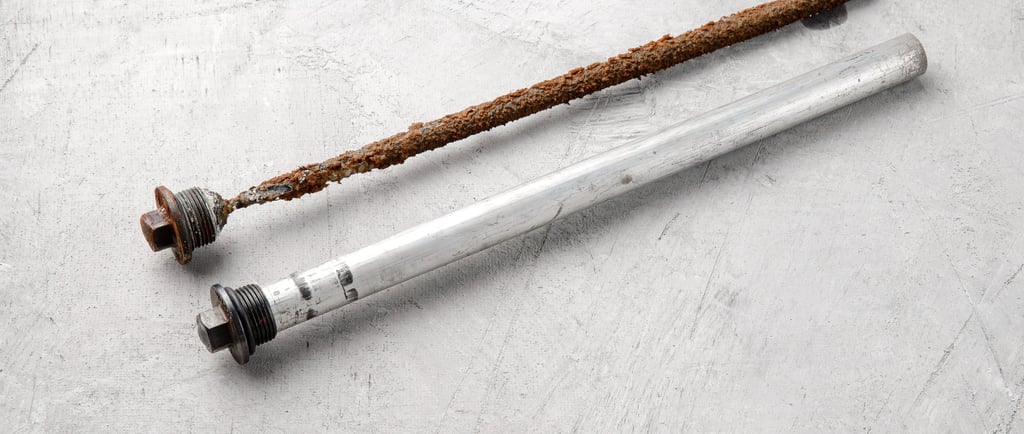Budget-Smart Water Heater Hack: Spend $350 to Avoid a $2,000 Bill
COST-SAVING PLUMBING TIPSRESIDENTIAL PLUMBINGWATER HEATERSPREVENTIVE PLUMBING TIPS
4/23/20253 min read


Your water heater is one of the most important appliances in your home, quietly working in the background to ensure you have hot showers, clean dishes, and warm water when you need it. But what happens when your water heater fails? A sudden replacement can set you back thousands—a cost most homeowners aren’t eager to face. The good news is that with a simple $350 investment in routine maintenance, you can dramatically extend your water heater’s lifespan. The secret lies in a small but vital component: the anode rod.
What Is an Anode Rod and Why Does It Matter?
The anode rod is a metal rod installed inside your water heater tank. Made of magnesium, aluminum, or zinc, it serves as a "sacrificial" component, designed to attract corrosive elements in the water that would otherwise damage the steel tank. Over time, these corrosive elements eat away at the anode rod instead of the tank, effectively protecting it from rust and premature failure.
Without a functioning anode rod, your water heater tank becomes vulnerable to corrosion. Eventually, rust will take hold, leading to leaks and structural damage that make replacement inevitable. That’s why replacing the anode rod every few years is a critical and cost-effective step to extend the life of your water heater.
The High Cost of Ignoring Your Anode Rod
Failing to replace a worn-out anode rod can have expensive consequences. Once the rod is depleted, there’s nothing left to prevent rust from forming inside your water heater. The result? A rusty tank that may start leaking or completely fail.
When your water heater gives out, the replacement cost can easily exceed $2,000 to $3,000, especially if the failure causes water damage in your home. Compare that to the $350 average cost of replacing an anode rod—a fraction of the price of a new unit—and it’s clear why this small maintenance task is so important.
How Replacing the Anode Rod Adds Years to Your Water Heater
As of 2024, a typical residential water heater is designed to last around 10–15 years, but this lifespan can be shortened significantly if the anode rod is neglected. By replacing the rod every 3 to 5 years, you can extend your water heater’s life well beyond its average expectancy. Many homeowners who stay on top of this maintenance step find their water heaters lasting 20 years or more, saving thousands in replacement costs.
This routine task also improves the efficiency of your water heater. A tank that remains free of rust and sediment buildup will heat water more effectively, keeping your energy bills in check while maintaining a reliable supply of hot water.
Signs Your Anode Rod Needs Attention
Not sure if your anode rod needs replacing? Here are some signs to watch for:
Rusty or Discolored Water: If your hot water starts appearing rusty or orange-tinted, it could mean the anode rod is no longer protecting your tank from corrosion.
Unusual Smells: A rotten egg smell in your hot water often indicates that the anode rod is deteriorating or reacting with bacteria in the tank.
More Than 3-5 Years Since Last Maintenance: If your water heater has not been serviced recently, chances are the anode rod is due for replacement.
For peace of mind, consider scheduling an annual water heater inspection. A professional plumber can assess the condition of your anode rod and recommend a replacement if necessary.
How to Replace an Anode Rod
Replacing the anode rod is a straightforward task for a professional plumber. It involves draining a portion of your water heater, removing the old rod, and installing a new one. While some homeowners may undertake this as a DIY project, it requires specialized tools and knowledge of your water heater’s specific components. Hiring a professional is strongly recommended to ensure the job is done safely and correctly without risking damage to your unit.
Conclusion: A Smart Investment in Your Home
Spending $350 to replace an anode rod might not sound exciting, but it’s one of the smartest investments you can make in your home’s plumbing system. This simple and budget-friendly maintenance step can prevent the frustration of a water heater failure, save you thousands of dollars, and add years to the life of your water heater.
If you’re unsure about the state of your water heater or when your anode rod was last replaced, contact a trusted plumber. By staying proactive, you can enjoy peace of mind knowing you’ve taken steps to protect your water heater—and your wallet.
Contact
Main Office
Social
3560 S 2200 W
West Valley City, UT 84119
P.O. Box 25123
Salt Lake City, UT 84125
Monday – Friday:
7:00 am – 3:30 pm
Billing & Mailing Address
Hours
© Budd M. Rich Plumbing Company, DBA BRPI Mechanical. All rights reserved.
